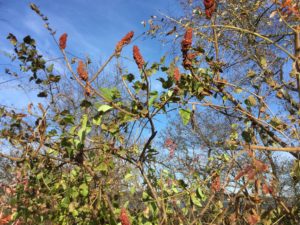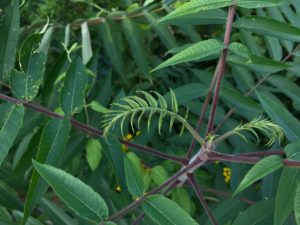Common Name: Staghorn Sumac, Velvet Sumac
Specific Name: Rhus typhina
Known Occurrence at Taylor Point:
Map Areas: Beach 1A, Beach 1C, Cliffs 2C, Cliffs 2D, Cliffs 2F, Woodland 3A, Woodland 3B, Woodland 3C, Roadside 5A
Category: Native, Shrub

Ecological Considerations:
Rhus typhina, commonly called Staghorn Sumac, is an open, colony-forming shrub that typically grows 15-25’ tall. It is particularly noted for the reddish-brown hairs that cover the young branchlets in somewhat the same way that velvet covers the horns of a stag (male deer), hence the common name. It is also noted for its ornamental fruiting clusters and excellent fall foliage color.
Staghorn Sumac has large, compound, odd-pinnate leaves (each to 24” long) that are bright green above during the growing season and glaucous beneath. Leaves turn attractive shades of yellow/orange/red in autumn. Each leaf has 13-27 toothed, lanceolate-oblong leaflets (each to 2-5” long). Tiny, greenish-yellow flowers bloom in terminal cone-shaped panicles in late spring to early summer (June-July), with male and female flower cones primarily occurring on separate plants (dioecious).
Female flowers produce showy pyramidal fruiting clusters (to 8” long), with each cluster containing numerous hairy, berry-like drupes that ripen bright red in autumn, gradually turning dark red as they persist through much of the winter.
Map areas where this plant can be used for revegetation:
Cliffs 2D
Woodland 3C
Propagation Mechanisms/Strategies for Encouraging its Establishment:
Staghorn Sumac is a suckering shrub that will form thickets in the wild via self-seeding and root suckering. Sumacs fail to compete with invading tree species and are seldom found growing under a closed canopy.
Best Planting Practices/Options and Pros and Cons of Options:
Staghorn Sumac is easily grown in average, dry to medium moisture, well-drained soils in full sun to part shade. It is tolerant of a wide range of soils except for those that are poorly drained.
Key Issues Regarding its Ecology:
Associated Ecological Benefits:
The fruit of the Staghorn Sumac is attractive to wildlife.
Availability of Locally Sourced Seeds and Plants:
The Farmer’s Daughter http://www.thefarmersdaughterri.com
Wildwood Nurseries http://wildwoodri.com
Rhody Native Rhody Native
Case Studies of Native Plant Establishment Efforts/Lessons Learned:
Additional Photos:


Sources Cited:
Rhode Island Native Plant Guide
Missouri Botanical
Key Words:
Native
Shrub
Rhus typhina
Staghorn Sumac
Velvet Sumac
rupes
dioecious
Potter Cove Beach
Taylor Point Cliffs
Black Cherry Woodland
Roadside 5A
1A, 1C, 2C, 2D, 2F, 3A, 3B, 3C
